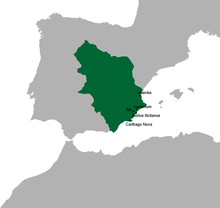Battle of Cartagena (461)
This article may contain an excessive number of citations. (October 2023) |
| Battle of Cartagena | |||||||
|---|---|---|---|---|---|---|---|
| Part of the Fall of the Roman Empire and Roman–Germanic Wars | |||||||
 Although the battle took place on the coast of the province Carthaginensis (green), it was not in the provincial capital Cartagena itself, but 40 nautical miles away in Portus Ilicitanus (Santa Pola) | |||||||
| |||||||
| Belligerents | |||||||
| Vandals | Western Roman Empire | ||||||
| Strength | |||||||
| Unknown | 300 ships[5][6][7][4] | ||||||
| Casualties and losses | |||||||
| Unknown | Unknown | ||||||
The Battle of Cartagena occurred on May 13, 460[1][5][2][6][7][3][8] or 461[4] and was part of the wars of Majorian. Although many sources call it battle of Cartagena, the battle did not take place at Cartagena but on the coast of Roman Carthaginensis province at Portus Ilicitanus (today Santa Pola)[1][2][4] in the bay of Alicante.[7] Since Portus Ilicitanus was the port of Elche (Ilici), the battle is sometimes referred as battle of Elche.[1][3]
460: Eo anno captae sunt naves a Vandalis ad Elecem juxta Carthaginem Spartariam.
— Marius Aventicensis, Chronica de obispo de Aventicum
Background
[edit]In 457, the Roman general Majorian succeeded to the throne of the Western Roman Empire. He immediately set about restoring the empire to its former boundaries. Majorian then began to assemble a fleet at Portus Ilicitanus (near Ilici),[1][2][3][8][4] with which he intended to invade the Vandal Kingdom in North Africa.
Battle
[edit]By spring 460[1][5][2][6][7][3][8] (or 461[4]), Majorian had 300[5][6][7][4] ships already built and he would have had another few more ready by the autumn. The Vandals decided to strike before the Roman navy became unbeatable. On May 13, a fleet of Vandal ships under the command of King Gaiseric[1][5][7] surprised the Roman fleet. Many of the Roman captains had been bribed to switch sides. The Roman navy was totally destroyed, ending any hope of reconquering North Africa.
Mense Maio Majorianus Hispanias ingreditur imperator: quo Carthaginiensem provinciam pertendente, aliquantas naves quas sibi ad transitum adversum Wandalos praeparabat, de littore Carthaginiensi commoniti Wandali per proditores abripiunt. Majorianus ita sua ordinatione frustratus ad Italiam revertitur.
— Hydatius, Chronicon
Sources
[edit]- ^ a b c d e f g Ian Hughes: Gaiseric - The Vandal Who Destroyed Rome, pages 61, 95 and 151–165. Pen and Sword, Barnsley 2017
- ^ a b c d e Michael Kulikowski: Late Roman Spain and Its Cities, page 191. JHU Press, Baltimore 2010
- ^ a b c d e John Powell: Magill's Guide to Military History, Vol. 3, page 936. Salem Press, Ipswich 2001
- ^ a b c d e f g Peter Heather: The Fall of the Roman Empire - A New History of Rome and the Barbarians, page X. Oxford University Press, New York 2005
- ^ a b c d e Tony Jaques: Dictionary of Battles and Sieges, Vol. 1 (A-E), page 205. Greenwood Publishing Group, Westport/London 2007
- ^ a b c d Simon MacDowall: Conquerors of the Roman Empire - The Vandals, page X. Pen and Sword, Barnsley 2016
- ^ a b c d e f Britannica.com: Majorian - Roman emperor
- ^ a b c Brill Online: Ilici
